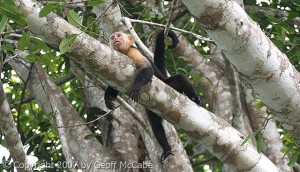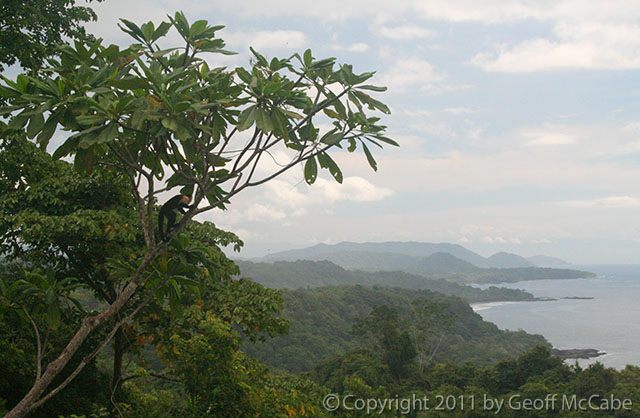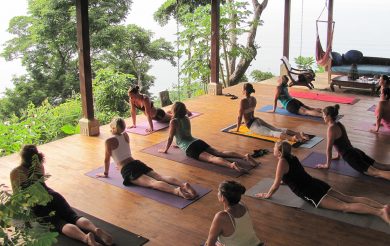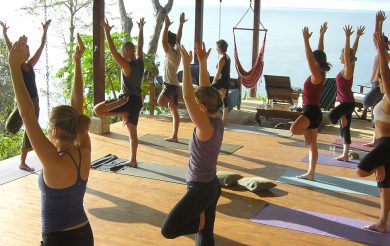- Home
- Accommodation
- Activities
- Area Info
- Maps
- Photo Galleries
- Real Estate
- Travel
White Faced Capuchin Monkey
Spanish Name: Carita Blanca
Found In: They are found in the wet lowland forests on the Caribbean coast of Costa Rica and Panama and deciduous dry forest on the Pacific coast.
Height/Weight: Adults are generally 2.5 to 3.5 kg; males are a little larger than females.
Life Span: 50 years
 The white faced capuchin monkeys are easily distinguishable in appearance from other primates in the Central American region. They have a dark body with a light upper chest and shoulders, and a white face with a black cap like marking on their head. Capuchins can be black, dark brown, or a white-ish color, it actually depends on the exact species. They are normally 12 to 22 inches with a prehensile tail longer than the rest of their body. They are diurnal and arboreal in nature, and can regularly be spotted using their prehensile tails and sturdy limbs to sway from one canopy to another. Their group size is about 12-25 members, with one popular alpha male leading the troop. Females have a single baby every couple of years, who holds on to the mother for the few months.
The white faced capuchin monkeys are easily distinguishable in appearance from other primates in the Central American region. They have a dark body with a light upper chest and shoulders, and a white face with a black cap like marking on their head. Capuchins can be black, dark brown, or a white-ish color, it actually depends on the exact species. They are normally 12 to 22 inches with a prehensile tail longer than the rest of their body. They are diurnal and arboreal in nature, and can regularly be spotted using their prehensile tails and sturdy limbs to sway from one canopy to another. Their group size is about 12-25 members, with one popular alpha male leading the troop. Females have a single baby every couple of years, who holds on to the mother for the few months.
The White-faced Capuchi is mostly found in the wet lowland forests of Cost Rica’s Caribbean coast and Panama and the deciduous dry forests on the Pacific side. They are found up to a height of 1500 meters in Costa Rica.
Capuchins have the most varied diet among all new world primates. Most of their waking time is spent traveling and foraging, beginning at daybreak and moving until they stop for the night. Sowing to the white faced capuchins varied diet, their habits have an impact of the vegetation in their habitats. They help in dispersing seeds, pruning trees (thus stimulating branching) and eating harmful, plant damaging insects. In some instances, their resolute actions have detrimental effects. For instance, in the process of consuming ant colonies living inside barks of trees they, capuchins can get destructive and attack the plants in their bid to get to the ants.
White Faced Capuchin monkeys have a gestation period of about 5 to 6 months and after that, the female gives birth to a single baby. A majority of the capuchin births occur during December – April in the dry weather. Female capuchins carry their babies on ther back for about 6 weeks, but about the 4th or 5th week, the infant is capable of straying for a short while and in about 3 months it moves around independently. The young ones quickly learn to play with other infants and food foraging habits.
Tourists who venture into the forest interiors in Costa Rica on their wildlife watching and hiking trails can spot these creatures around the Arenal Volcano National Park and the Monteverde Cloud Forest Reserve, in the Cano Negro National Wildlife Refuge in the the Nicaragua border vicinity, Carara National Park and in large La Amistad International Park.

Capuchins are easily spotted in many of Costa Rica’s national parks, including those in the northwestern region such as Santa Rosa National Park. In the northern region of the park, capuchins occupy the Junquillal Bay National Wildlife Refuge in the Santa Elena Gulf. Capuchins are also seen at the Cabo Blanco Reserve at the southern tip of the Nicoya Peninsula and on many Costa Rica boat tours in the mangroves of Tamarindo National Wildlife Refuge adjacent to Las Boulas Marine National Park. The commonly inhabited Northern inland areas of the capuchin monkeys include Guanacaste National Park, Rincon de la Vieja National Park and the forests of Barra Honda National Park as well as the Lomas de Barbudal Biological Reserve to the north of Palo Verde National Park.
In central Costa Rica, capuchins are seen around the inland in the Monteverde Biological Cloud Forest Reserve, Juan Castro Blanco National Park, Braulio Carrillo National Park, Carara National Park and Tapanti National Park and La Armistad International Park. On the central Pacific side, capuchins can be seen at the Manuel Antonio National Park and the Damas Island juxtaposed between the park and the Parrita town. Further south is Piedras Blancas National Park, next to the Osa Peninsula where these primates can be seen moving about in large groups. Visitors on guided Costa Rica tours to the Caribbean coast may also spot these quirky mammals in the Tortuguero National Park. A trip to the Manuel Antonio Park will dramatically enhance your chances of spotting this species since they are present in huge numbers at the park.
For More Information on White Faced Capuchin Monkeys
http://www.costaricajourneys.com/white-faced-capuchin/
http://costarica.com/wildlife/white-faced-monkeys/
Great Stuff

Clandestina Restaurant
My new favorite restaurant, Clandestina is not to be missed by food lovers staying anywhere near to Montezuma. Established in March 2015, Clandestina is the new kid on the block. The Oregon/Tico collaboration is a winner among locals and travelers alike, with artisan craft beers, made onsite by Butterfly Brewing Co. and delicious, exciting […]











